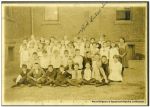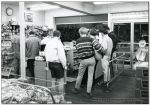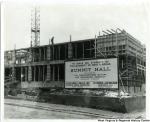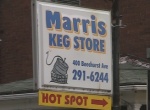*** REORDER BASED ON LOGICAL WALKING PATH ***
A. Begin: Pre-industrial Sunnyside
Seneca Center parking lot
In February 1886, the Baltimore and Ohio Railroad opened a branch between Morgantown and Fairmont, with connections as far as New York City and St. Louis. Morgantown’s river highway, the Monongahela, carried a line of first-class steamboats arriving and departing each day. Prominent Morgantown citizens harnessed the potential of these new systems and sought to advance the city’s growth, including the newly formed Morgantown Building and Investment Company (MBIC) in January 1892, which sought to expand the railroad and encourage industrial and residential development. The MBIC purchased swaths of briar fields below Falling Run. Within the year, the company constructed Beechurst Avenue, extended the railroad, and actively pursued industrial entrepreneurs and residents to settle in the Sunnyside neighborhood.
B. Turn Verein Club House
487 McLane Avenue
The vast waves of ethnically diverse immigrants that arrived in Sunnyside during Morgantown’s early 20th century industrial boom brought cultural traditions that dominated life in the immigrant neighborhoods. Turn Verein Concordia was a unique cultural center that offered German glass workers a sense of community. Although Germans were not the dominant ethnic group by population, they played a significant role as skilled workers and glass factory directors, many with ties to Seneca Glass. Initially established as an athletic club, Turn Verein developed into a place for dances, union meetings, and social drinking. The two-story frame structure that housed a gymnasium and dance hall opened with a grand ball in May 1898. World War I signaled the likely decline in the club’s activities and subsequently the building was used as a gymnasium by Italian immigrants before its lots were replaced by student rental housing.
 C. Seneca School
C. Seneca School
300 McLane Avenue
The development of glass factories in Morgantown between 1896 and 1920 spurred a tremendous population growth, causing a boom in the construction of local free schools, one of which was the Seneca Elementary School, Fourth Ward built in 1904. Prior to 1904, the German Baptist Church in Seneca was rented at the rate of ten dollars per month for use as a school, however students soon outgrew the space. Seneca school served as an elementary school until 1967, when the county board of education consolidated students within a new grade system. At this point, it remained within the school system and instead housed the county school library and the county resources center. Between 1983 and 1985, Melvin Friend purchased the Seneca School and converted it into the McLane Manor Apartments, expanding it to nine units over the years. Throughout the 1990s, there were as many as twenty-seven people living in the complex with at the most seven in one unit, and today the building remains a student rental facility.
D. St. Francis de Sales Church
663 McLane Avenue
St. Francis Catholic Church, the first Catholic Church in Morgantown, was constructed at the turn of the twentieth century. Many of the new glass workers who relocated from all over Europe to Morgantown to find work in factories such as Seneca Glass were Catholic. On July 17, 1898, the building was dedicated under the patronage of St. Frances de Sales and services were held in both English and German. The church likely represented a return to normalcy for many immigrants whose Catholic background was a substantial part of their previous life in Europe. The structure was occupied as a church until 1924, when the chapel relocated to Beechurst, and subsequently found use as a gymnasium and multi-use community space until it collapsed during a tornado on May 2, 1929 which additionally destroyed seventy-five houses.
E. Craftsman bungalow house
240 McLane Avenue
240 McLane Avenue is a craftsman style house, typical of the Modern architectural movement characterized by structural simplicity. The Craftsman style dominated homes built from 1905 through the early 1920s, originating in California but spreading across the nation through pattern books and popular magazines. The house at 240 McLane Avenue is a two-story structure built with a low-pitched, side gabled roof and characteristically features a large front porch. The durable synthetic siding and back porch signal modifications to the home, however it characterizes the typical architectural style of functional homes in the early 20th century. The house was primarily occupied by renters from the 1920s up to the present day, which is characteristic of the neighborhood.
 F. Chico’s Family bakery
F. Chico’s Family bakery
407 Beechurst Avenue
The Chico family is famously known for Julia’s pepperoni rolls, the production of which is the primary function of the bakery on this site today. Chico Bakery, formally known as Chico Dairy Company, initially opened business in 1925 and was based on different sites along Beechurst in previous incarnations. The family patriarch, Samuel, was born in Italy. The current property came into the family’s hands in 1971. The bakery currently resides in on a block that will likely be demolished in upcoming years, forcing Chico’s Bakery to once again relocate or fight to keep their current location.
 G. Sunnyside Superette
G. Sunnyside Superette
2045 University Avenue
Sunnyside Superette, a local grocery and convenience store, was a fixture of the Sunnyside neighborhood since the late 1940s. The site originally housed Russos Shoe Repair before being replaced by a Texaco Service Station, which eventually closed at the end of World War II and primed the site for the Superette Market Grocery, opened by the De Biase family between 1946-1949 after an earlier incarnation as the Sunnyside Fruit Market that they ran nearby. The store remained under three generations of family management until 1997, when the family sold the store and company. Due to its prime location and proximity to campus, the shop catered to WVU students before shuttering in 2015, likely due to the new construction of the University Place housing complex which included a new Sheetz that sold competitive products, turning Sunnyside Superette into another small business victim of the increasing arrival of national chains.
H. Student boarders
18 McLane Avenue
The house at 18 McLane Avenue, constructed between 1906 and 1911, reflects patterns in industrialization and migration to Morgantown and has a long history of use as a multi-family home and rental property. Its unique architectural style includes a brick construction with a wooden and stone double story porch, which has undergone extensive renovations. It contains many large windows with ornamental brick arches across the top. The house has a total of three doors today, although at least one may have originally been a window. Ownership of the home changed hands over the years, however residents were primarily renters from as early as 1920, and included factory workers, professionals, and families. A major shift in the neighborhood occurred after World War II as a result of new GI Bill benefits which expanded education opportunities and resulted in the domination of university student renters in houses such as this.
 I. Summit Hall
I. Summit Hall
211 Grant Avenue
Summit Hall, a West Virginia University student dorm built in 1966, represents early instances of West Virginia University’s steady capturing of the Sunnyside neighborhood as an extension of the university. It is located only two blocks from the Life Sciences Building, easily within walking distance of the whole downtown campus. The increasing development of student units reflects the strength of yet another industry – university education – as the primary player in Sunnyside.
 J. Marris Keg Store
J. Marris Keg Store
Fourth and Beechurst
Students were fond of Marris Keg Store as the prime place to buy kegs. Although it was known for its convenient location, low prices and for serving the “best breakfast sandwich in town,” this family-owned store eventually shuttered due to bankruptcy after 25 years of operation.
 K. Mutt’s / University Place
K. Mutt’s / University Place
2129 University Avenue
This site changed hands many times over the years since the former building’s construction in 1901, featuring families of glass workers as well as industrial and student renters. Mottie “Mutt” Pavone, the son of Italian immigrants, and his wife Rose Poropatt Pavone, a Yugoslavian immigrant, initially opened Mutt’s Sunnyside Place Pub in 1935 in a different location on Beechurst Avenue, however after a fire destroyed the property it relocated to the University Avenue location in 1979. Around this time, Sunnyside became known as a place for university students to party and drink, and Mutt’s offering of drinks and an “all-you-can-eat” spaghetti lunch on Saturdays solidified its importance as an institution for students. Much to the chagrin of students and nostalgic alumni, Mutt’s was demolished in 2013 along with 39 surrounding properties to pave the way for University Place, a complex of high-rise apartments developed through the partnership of the Sunnyside Up organization, West Virginia University, and private developers.
 L. Caperton Trail (Rail Trail)
L. Caperton Trail (Rail Trail)
Riverfront trail
In the 1880s, Morgantown’s industrial capacity grew with the arrival of the railroad. The ability to ship goods farther than the Monongalia and Ohio River Valleys brought new industries needing the area’s raw materials. Most of these industries were from out-of-state interests. The abandoned rail corridor that is now the Mon River / Caperton / Deckers Creek Trail System was purchased from CSX Railroad and is now held in a lease with the WV State Rail Authority. It is financially supported through Transportation Enhancement and Recreational Trail funds and by business and community donations. Today, the rail trails is a multi-purpose public path that offers opportunities for bicycling, walking, running, and other activities, and also serves as a wildlife conservation corridor, linking isolated parks and creating greenways through developed areas, stimulating tourism and local business.